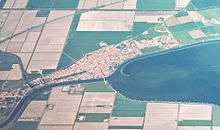Comacchio
| Comacchio | |
|---|---|
| Comune | |
| Comune di Comacchio | |
|
Trepponti (1638), built by Giovanni Pietro da Lugano to a design by Luca Danese of Ravenna | |
 Comacchio Location of Comacchio in Italy | |
| Coordinates: 44°42′N 12°11′E / 44.700°N 12.183°ECoordinates: 44°42′N 12°11′E / 44.700°N 12.183°E | |
| Country | Italy |
| Region | Emilia-Romagna |
| Province / Metropolitan city | Ferrara (FE) |
| Frazioni | Lido degli Estensi, Lido degli Scacchi, Lido di Pomposa, Lido di Spina, Porto Garibaldi, San Giuseppe, Lido delle Nazioni, Lido di Volano, Vaccolino, Volania |
| Government | |
| • Mayor | Marco Fabbri (M5S) |
| Area | |
| • Total | 283 km2 (109 sq mi) |
| Elevation | 1 m (3 ft) |
| Population (30 April 2009) | |
| • Total | 23,072 |
| • Density | 82/km2 (210/sq mi) |
| Demonym(s) | Comacchiesi |
| Time zone | CET (UTC+1) |
| • Summer (DST) | CEST (UTC+2) |
| Postal code | 44022 |
| Dialing code | 0533 |
| Patron saint | San Cassiano |
| Website | Official website |
Comacchio [koˈmakkjo] is a town and comune of Emilia Romagna, Italy, in the province of Ferrara, 48 kilometres (30 mi) from the provincial capital Ferrara.
Geography


Comacchio is situated in a lagoon just north of the present mouth of the Reno. It is built on more than thirteen different islets, joined by bridges. The most important resources of these wetlands are the fish farming and the salt ponds. The seaport of Porto Garibaldi lies 7 kilometres (4 mi) to the east. The wetlands south of the town, the Valli di Comacchio, are classified as a Site of Community Importance and a Special Protection Area in Italy.[1] They are also rated internationally important by the Ramsar Convention for the conservation and sustainable use of wetlands.[2]
History
After its early occupation by the Etruscans and the Gauls, when the site lay on the main stream of the River Po, Comacchio was annexed by Rome. Under Emperor Augustus, who ruled Rome from 27 BCE to 14 CE, a canal was dug to deepen its lagoon. Part of the original wetlands were drained and divided among villae rusticae.[3]
Comacchio enjoyed prosperity under the Goths and the Lombards, and became the seat of a Lombard duchy. It owed its fortunes to its salt pans and its strategic importance to its location: when the Lombard king Authari expanded the Lombard dominion at the expense of Byzantium, he took the fortress of Comacchio and cut off communication between Padua and Ravenna. When the Franks descended into northern Italy in 756, their king, Pepin the Short, included Comacchio in his famous donation of land to Pope Stephen II, a grant later confirmed by Pepin's son and successor, Charlemagne. In 854 Comacchio was sacked by their rivals in the salt trade, the Venetians, who laid it waste in 946. Saracen raiders burned the city in 876, but despite this Comacchio slowly recovered.[4] The Holy See later acquired the city and presented it to the archbishopric of Ravenna.
In the 13th century, Emperor Rudolph I conferred it on Obizzo IV d'Este of Ferrara. In 1508 it became Venetian, but in 1597 was claimed by Clement VIII as a vacant fief. In 1598 the Papal States again acquired Comacchio and retained it until 1866 when it became a part of the Kingdom of Italy. The spread of malaria rendered the site unhealthy.[5]
Since then, most of the swamp land has disappeared, leaving ground for the expansion of agriculture, and creating new zones for dwellings.
Comacchio was formerly the seat of a bishopric and retains its cathedral, now a co-cathedral in the Archdiocese of Ferrara-Comacchio.
The town was once home to a factory for sugar refining, which closed in 1988. Comacchio and its seafront Lidi are a center for tourism.
World War II
The area was the scene of fierce fighting in the last months of the war.[6]
References
| Wikimedia Commons has media related to Comacchio. |
- ↑ "Siti di importanza comunitaria e zone di protezione speciale" (PDF) (in Italian). Emilia-Romagna regional administration. September 2010. Retrieved 2011-04-29.
- ↑ "The List of Wetlands of International Importance" (PDF). The Secretariat of the Convention on Wetlands. 21 April 2011. p. 21.
- ↑ Italy World Club: Comacchio
- ↑ The Italian Cities and the Arabs before 1095, Hilmar C. Krueger, A History of the Crusades: The First Hundred Years, Vol.I, ed. Kenneth Meyer Setton, Marshall W. Baldwin, (University of Pennsylvania Press, 1955), 49.
- ↑ "It is needless to add that the neighborhood is very unhealthy", Charles Knight, ed., The English Cyclopedia: Geography, 1854, s.v. "Ferrara".
- ↑ Langley, Mike (1988). Anders Lassen, V.C., M.C., of the S.A.S. ISBN 978-0450424922.
 This article incorporates text from a publication now in the public domain: Chisholm, Hugh, ed. (1911). "article name needed". Encyclopædia Britannica (11th ed.). Cambridge University Press.
This article incorporates text from a publication now in the public domain: Chisholm, Hugh, ed. (1911). "article name needed". Encyclopædia Britannica (11th ed.). Cambridge University Press.